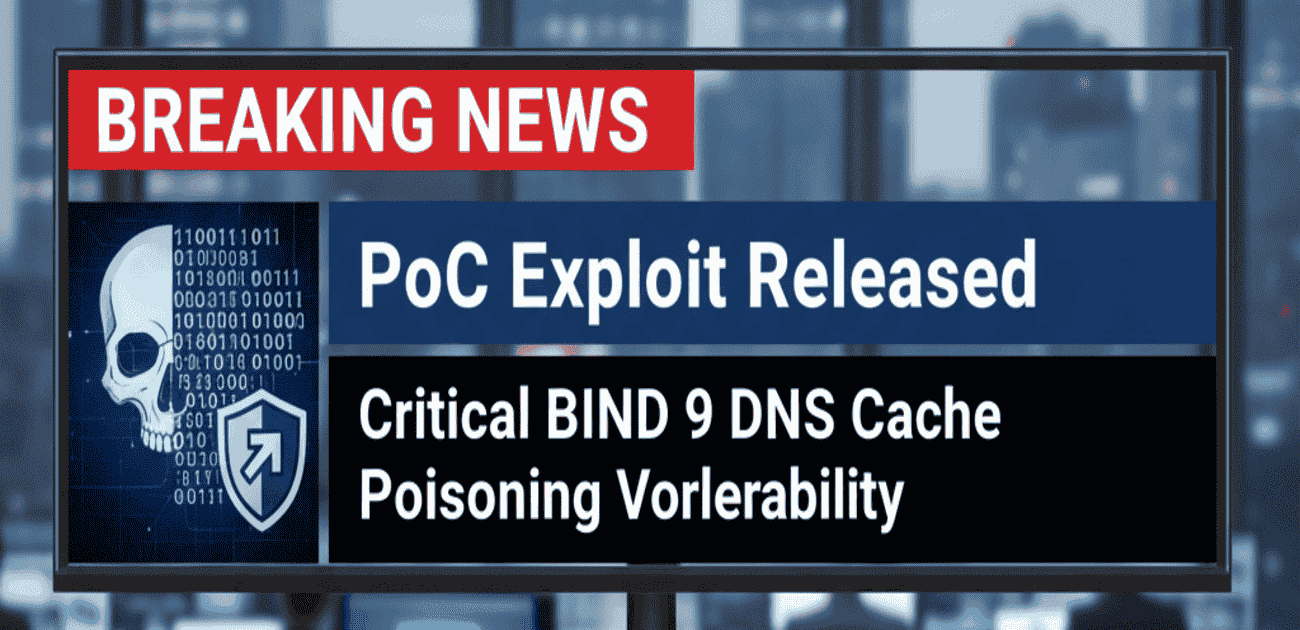CRITICAL SECURITY ALERT
Public exploit code released for CVE-2025-40778 – Immediate patching required!
October 29, 2025 – Cybersecurity researchers have released a public proof-of-concept (PoC) exploit for the critical BIND 9 DNS cache poisoning vulnerability (CVE-2025-40778), significantly increasing the risk of widespread attacks across internet infrastructure.
BREAKING / LATEST UPDATE
URGENT UPDATE: Public exploit code is now available, making this vulnerability significantly more dangerous. Security administrators must prioritize immediate patching to prevent potential DNS hijacking attacks.
The Internet Systems Consortium (ISC) initially disclosed this critical flaw on October 22, 2025, revealing a dangerous weakness in the world’s most widely used DNS software. The vulnerability affects BIND 9 versions 9.11.0 through 9.21.14, potentially impacting millions of users worldwide.
VULNERABILITY OVERVIEW
CVE-2025-40778 represents a critical DNS cache poisoning vulnerability that allows remote, unauthenticated attackers to inject forged DNS records into resolver caches. This attack can redirect millions of users to malicious infrastructure without any user interaction or special network access.
CVE DETAILS
| CVE Details | Information |
|---|---|
| CVE ID | CVE-2025-40778 |
| Affected Versions | BIND 9.11.0 through 9.21.12 |
| Vulnerability Type | DNS Cache Poisoning |
| CVSS v3.1 Score | 8.6 (High) |
Key Vulnerability Details:
- CVE ID: CVE-2025-40778
- CVSS Score: 8.6 (High Severity)
- Affected Versions: BIND 9.11.0 through 9.21.14
- Vulnerability Type: DNS Cache Poisoning
- Attack Vector: Remote, Unauthenticated
- Impact: DNS Traffic Redirection
TECHNICAL ANALYSIS
The vulnerability exploits BIND’s handling of unsolicited resource records, allowing attackers to bypass modern DNS security defenses that were implemented following the infamous 2008 Kaminsky vulnerability. This earlier flaw led to randomized query IDs and source ports, protections that CVE-2025-40778 circumvents entirely.
Attack Mechanism:
By crafting specially formatted DNS responses, attackers can poison resolver caches and redirect legitimate traffic to attacker-controlled servers. The attack carries a CVSS 3.1 severity score of 8.6, classified as high severity, reflecting its potential for widespread impact across internet infrastructure.
Affected Systems:
The flaw affects supported BIND 9 versions ranging from 9.11.0 through 9.21.14, impacting any resolver performing recursive queries. Fortunately, authoritative-only servers remain unaffected by this issue.
IMPACT ASSESSMENT
The consequences of successful exploitation could be severe. Attackers could redirect all DNS traffic from an affected resolver to malicious endpoints, enabling:
- Phishing Campaigns: Redirecting users to fake banking and e-commerce sites
- Malware Distribution: Serving malicious software through compromised DNS responses
- Traffic Interception: Capturing sensitive data and credentials
- Service Disruption: Making legitimate websites inaccessible
Critical Impact: Given BIND’s ubiquitous role in internet operations, a single compromised resolver could affect thousands or millions of downstream users and systems.
MITIGATION STRATEGIES
ISC has released patched versions addressing this vulnerability: version 9.18.41, 9.20.15, and 9.21.14. The company coordinated disclosure through a responsible timeline, issuing early notifications on October 8, revising patch details on October 15, and finalizing disclosure on October 22.
Immediate Actions Required:
- Priority Patching: Upgrade to patched versions immediately
- Configuration Audit: Ensure recursive queries are disabled on authoritative-only servers
- DNSSEC Implementation: Deploy Domain Name System Security Extensions where feasible
- Network Monitoring: Implement comprehensive DNS behavior monitoring
- Security Assessment: Conduct thorough resolver configuration reviews
Long-term Security Measures:
- Implement comprehensive DNS monitoring and alerting systems
- Regular security assessments of DNS infrastructure
- Employee training on DNS security best practices
- Incident response planning for DNS-related attacks
VULNERABILITY TIMELINE
| Date | Event | Status |
|---|---|---|
| October 8, 2025 | Early notification issued | Completed |
| October 15, 2025 | Patch details revised | Completed |
| October 22, 2025 | Final disclosure | Completed |
| October 29, 2025 | PoC exploit released | Active |
EXPERT INSIGHTS
Security experts emphasize the critical nature of this vulnerability, particularly given the public release of exploit code. The combination of high severity, widespread impact potential, and available attack tools creates a perfect storm for cybercriminals.
Organizations must treat this as a top-priority security incident and implement immediate countermeasures. The window for proactive defense is rapidly closing as exploit code becomes more widely available.
INDUSTRY IMPACT
BIND 9 is the most widely deployed DNS software globally, powering critical internet infrastructure. The potential for widespread DNS cache poisoning attacks represents a significant threat to internet stability and user security.
Major internet service providers, cloud platforms, and enterprise networks rely heavily on BIND 9 for DNS resolution, making this vulnerability a concern for virtually all internet users.
IMMEDIATE NEXT STEPS
- Assess Your Infrastructure: Identify all BIND 9 installations in your environment
- Apply Patches Immediately: Upgrade to the latest patched versions
- Monitor for Exploitation: Implement comprehensive DNS monitoring
- Review Security Posture: Conduct thorough security assessments
- Update Incident Response Plans: Ensure readiness for DNS-related attacks
RELATED ARTICLES
For more information on DNS security and vulnerability management, check out these related articles:
- Samsung Galaxy S25 Zero-Day Vulnerability Exploited at Pwn2Own Ireland 2025
- New Android Banking Trojan Herodotus Mimics Human Behavior
CONCLUSION
The release of public exploit code for CVE-2025-40778 significantly increases the urgency of patching this critical BIND 9 vulnerability. Organizations must prioritize immediate action to prevent potential DNS cache poisoning attacks that could compromise millions of users.
This incident highlights the ongoing challenges in maintaining DNS security and the importance of rapid response to critical vulnerabilities. The cybersecurity community must remain vigilant and prepared to address emerging threats to critical internet infrastructure.
Stay Updated: Follow CyberUpdates365 for the latest cybersecurity news, vulnerability updates, and security best practices. Subscribe to our newsletter for real-time threat intelligence and expert analysis.
This article was written by the CyberUpdates365 editorial team based on official security advisories and industry analysis. For the latest updates on this vulnerability, visit our website regularly.
Cybersecurity Expert | DevOps Engineer
Founder and lead author at CyberUpdates365. Specializing in DevSecOps, cloud security, and threat intelligence. My mission is to make cybersecurity knowledge accessible through practical, easy-to-implement guidance. Strong believer in continuous learning and community-driven security awareness.


Leave a Reply